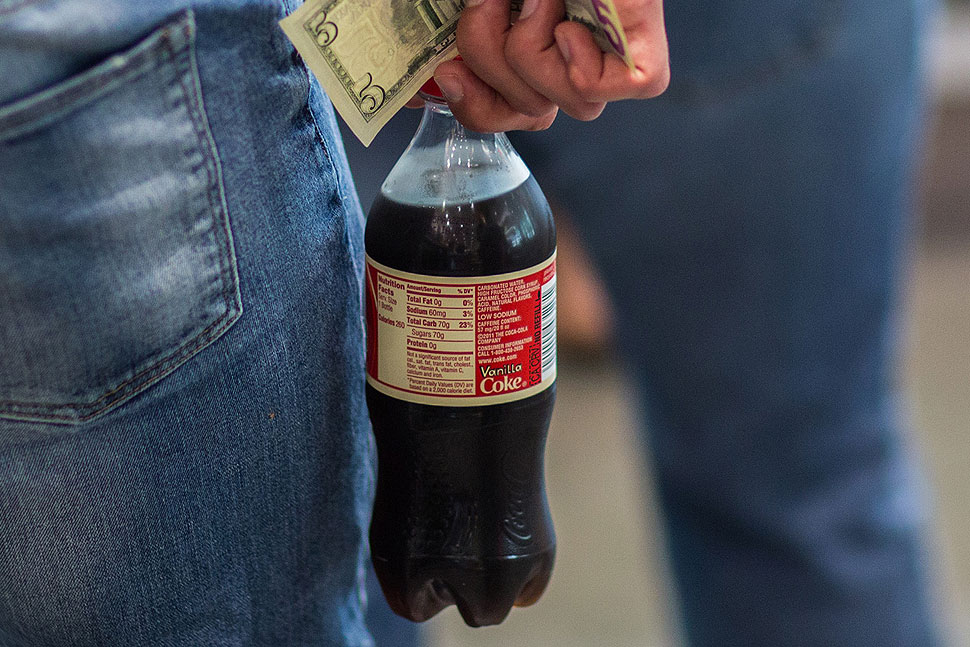A Chicago soda tax—which would apply to other "sweetened beverages" with a certain amount of sugar—looks to be a non-starter, according to a detailed Tribune piece that delves into the industry's previously successful lobbying efforts in the city. So, like a similar state-level effort, it may not come to a vote.
But…what if it did? Would it do what the city council's Health Committee chair, George Cardenas, hopes?
It would almost certainly raise revenue, one of his goals. The other goal, cutting consumption, seems less likely.
New—if preliminary—research on one soda tax suggests it can cut consumption. That research comes out of Mexico, whose residents consume more soda than anyone else on earth; diabetes is the number-one cause of death in the country. So last year the country passed a peso-per-liter soda tax. And it seems to be working:
According to the findings, the soda tax was effectively a 10 percent tax, and Mexicans bought 6 percent less of sugary drinks in 2014 as a direct result of the increased cost and awareness around it.
The reduction was across all incomes, with the largest—9 percent—among the poorest group. Furthermore, the impact is growing, with the end of the year marking notably fewer sales.
But Mexico is a country. Not only does that make the tax harder, if not impossible, to avoid by going elsewhere, by nature of it being a national effort, but also awareness is raised of a new, additional cost and the health reasons for implementing it.
Perhaps a better test is Berkeley's penny-per-ounce tax—the same price as Chicago's proposed tax—which began early this year. Shortly thereafter, two economists from Cornell and the University of Iowa, John Cawley and David Frisvold, examined how much prices had gone up in the wake of the tax. (A similar one was proposed in San Francisco with public support, but failed to win the two-thirds vote needed to pass, giving them a control group.)
And they found that prices didn't go up the full amount of the tax—which is part of the point:
Specifically, we find that average pass-through was less than 50%, far from the full pass-through found in much of the previous literature and assumed in simulations of such taxes. These results imply that the Berkeley soda tax, because it is passed through to consumers to a lesser extent than anticipated, will result in less of a reduction in consumption, and thus less health improvement, than anticipated.
In other words, stores were eating some of the price increase. They have some theories for that, and it's worth noting (as they do) that it would take more than the three months of data they gathered for the new tax to be fully passed along to consumers—although prior studies suggested that would be unlikely.
Another is the fear usually cited by opponents of such taxes: that people will simply evade the tax by buying the taxed good outside of the municipality. Berkeley could be particularly vulnerable to this, being a mere 10.5 square miles.
But then there's this: "Stores that increased prices by exactly the amount of the tax are often located close to stores that did not change their prices at all. This suggests that differences across stores in pass-through may not be determined by either elasticity of customer demand or ease of cross-border shopping."
In other words: maybe retailers genuinely don't know how best to address the additional tax. Do you pass it on to customers, assuming that demand is inelastic because soda pop is delicious and they'll buy it anyway? Or do you eat some or all of the tax and hope to make it up by selling more soda cheaper than the place down the street? Economists like to experiment with supply and demand; why can't store owners?
But causes aside, their study is pretty interesting, suggesting that we can't assume that an entire tax will get passed onto consumers via sellers, which has implications for the goal of reducing consumption and the amount of the tax.
That other goal? That's working pretty well. Berkeley, population 117,000, brought in $375,100 over the first three months, or about $1.07 per person. And while three months is itself a small sample size, there are no worries yet about revenue falling as pop drinkers get wise—revenues were about $15,000 higher in the third month than in the first.



